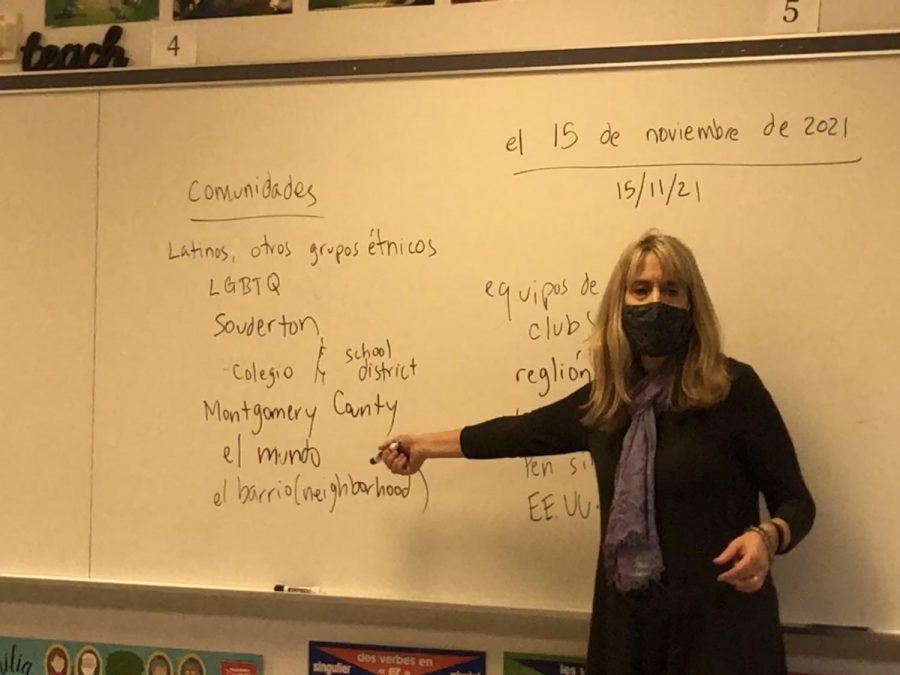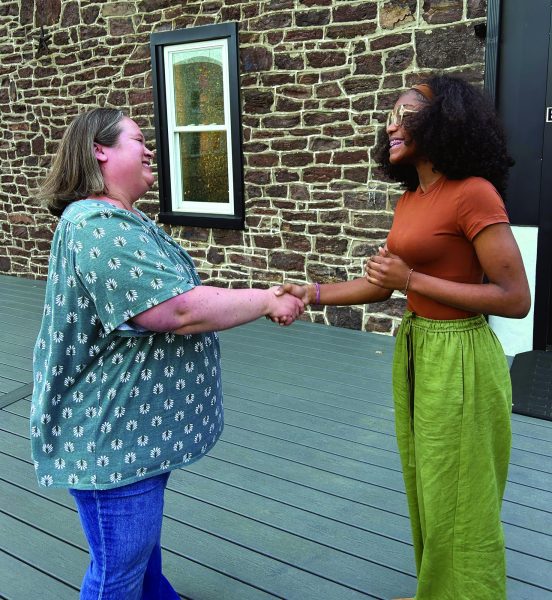World language teachers incorporate culture
Using interactive activities, world language teachers integrate aspects of culture while teaching in hopes of piquing the interest of their students. World language teachers try to immerse their students in culture so they develop a greater understanding and appreciation of differences.
Arrowhead photo by Brooke Bechtel
El mundo in the classroom…As a learning activity for her Spanish II class, world language teacher Christine Yardley has her students think of the different communities of which they are a part. The students gave Yardley numerous examples of communities they are involved in such as ethnic groups, Souderton, Montgomery County and “el mundo,” or the world.
Hoping to broaden the perspective of their students, world language teachers facilitate engaging and interactive activities in an attempt to include the language’s culture while teaching their students.
Some world language teachers run into difficulties incorporating culture as they have to fit the grammatical, vocabulary and conjugational curriculum required in the course.
According to Spanish teacher Alison Todd, “It’s difficult because of the material we have to cover academically, like the grammar and everything, so there’s not always a lot of time to get the culture in there.”
However, many teachers feel like it is important that the world language curriculum explores culture.
“Language is a part of culture and culture is a part of language,” French teacher Sally Cushmore said.
To many, learning a foreign language does not only mean education on a new verbal form of communication, but an entire ethnic group.
“When you learn a language, you not only learn how to say it, you also learn about the people who are from there and that’s why they think differently,” Chinese teacher Xia Pomposi said.
Music is often included as a part of learning about the culture.
World language teachers may play the cultural music of the country, both “current and old,” according to Cushmore.
French and Spanish teacher Christine Yardley does multiple different activities with the incorporation of music.
“We do a song of the week [or] similar things and discuss the country or song,” Yardley said. “Some of them are just like our pop songs from today and some [have] more historical or traditional significance.”
Yardley takes pride in knowing that often her students choose to continue listening to the foreign music outside of the classroom.
“I always think it’s a success whenever they tell me that they’re listening to [Spanish/French music] outside of class,” Yardley said.
Listening to the music of the culture has multiple purposes.
“We use it to learn culture and then also to practice our listening skills and enhance our vocabulary,” Yardley said.
As there are so many aspects of culture, the world language teachers look for ways to incorporate it as much as they can in their curricula.
“One day it might be food, one day it’s geography, one day it’s the history of a Spanish speaking country,” Todd said. “[We try] to kind of get it out there a little bit because sometimes it’s hard to incorporate culture.”
Celebrating major cultural holidays in the classroom gives a glimpse as to how other cultures celebrate their traditions.
For the Chinese New Year, Pomposi discusses the food people eat during that time as well as what the holiday represents to the Chinese people.
Todd has her students participate in a “Tomatina” or tomato fight.
The massive tomato fight occurs on the last Wednesday in August in Buñol, Spain in August which millions of people attend.
For an hour, the entire town throws tomatoes at each other in the middle of the streets.
While she does not give her students tomatoes, Todd makes them write something in Spanish on paper which they crumple up and throw.
“I know a lot of kids still talk about the Tomatina and they remember the facts about it because we did that,” Todd said. “So, it’s simple little things like that to kind of make more relevant and more real for them.”
Cushmore brings the Parisian metro or subway to her students by allowing them to travel around the school on the subway.
“We often do a metro activity where they have to pretend they’re taking the metro in Paris,” Cushmore said.
The students figure out the route they have to take using the French signs around the school telling them which subways go which direction and thus which ones they should “travel” on.
Cushmore hopes that when she teaches French, her students will learn “that people are different all around the world and to have an open mind” because the more “you learn about other cultures and other languages the more you learn about yourself.”
Yardley also wishes similarly for her students.
“I just want students to learn that people are different all around the world and to have an open mind and understanding that people are different and understanding cultural differences,” Yardley said.
According to Todd, understanding cultures is crucial when learning a language as there can be major differences, especially if traveling to the country is a possibility.
“It’s important to understand, just like [it is for us] to understand each other and who we are, it is important for you to understand the people you’re learning the language for because they’re going to have different customs,” Todd said.





